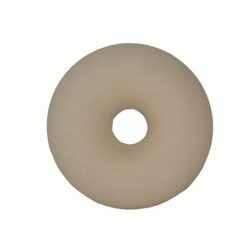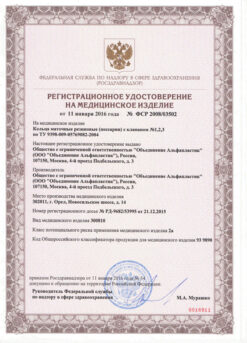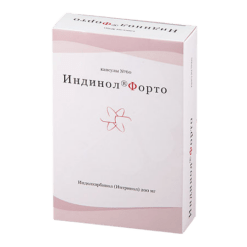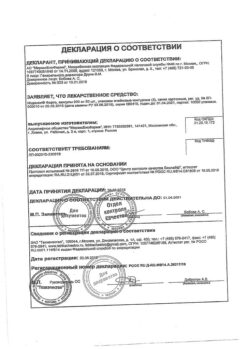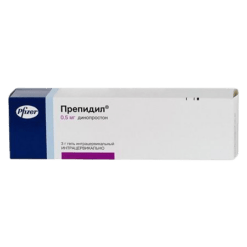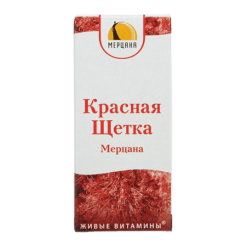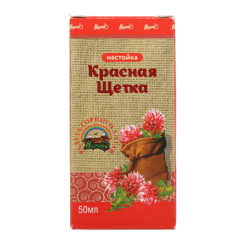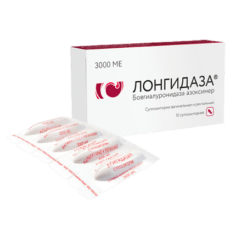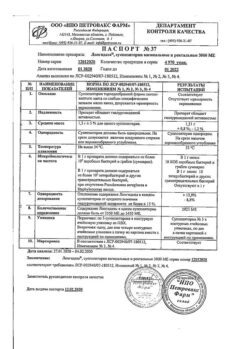No products in the cart.
Ovitrel 250 mcg/0.5 ml syringe pen
€1.00
Out of stock
(E-mail when Stock is available)
Description
Ovitrel has a gonadotropic, luteinizing effect.
Pharmacodynamics
Ovitrelle< sup>® contains choriogonadotropin alpha (CG alpha), which is produced using recombinant DNA technology. It has the same amino acid sequence as natural human HC. XH binds transmembrane LH receptors on the surface of theca and granulosa cells of the ovary. It causes initiation of oocyte meiosis, follicle rupture (ovulation), formation of the corpus luteum, and production of progesterone and estradiol by the corpus luteum.
Pharmacokinetics
Intake and distribution. After intravenous administration, HCG alfa is distributed to the extracellular fluid with a half-life of approximately 4.5 h.
The steady-state V< sub>d and total clearance are 6 L and 0.2 L/h, respectively.
When administered subcutaneously, HCG alfa has an absolute bioavailability of approximately 40% and a final T< sub>1/2 of approximately 30 h.
Elevation and metabolism. The metabolism and excretion of hCG alpha is similar to that of endogenous hCG.
Indications
Indications
In the protocol of induction of multiple follicle maturation (superovulation) for assisted reproductive technologies (including IVF) for the induction of final follicle maturation and luteinization after stimulation with gonadotropin preparations; in anovulatory or oligoovulatory infertility for induction of ovulation and luteinization at the end of follicle growth stimulation.
Active ingredient
Active ingredient
Composition
Composition
1 syringe contains:
Active ingredient:
Choriogonadotropin alpha 250 µg;
Associates:
Mannitol – 27.3 mg.
How to take, the dosage
How to take, the dosage
Ovitrel is administered by injection. Each syringe is for single use only.
When used in a multiple follicle maturation induction protocol for assisted reproductive technology (including For induction of final follicle maturation and luteinization after gonadotropin stimulation, Ovitrel is administered at a dose of 250 mcg (1 syringe) once 24-48 hours after the last FSH or LH infusion and after optimal follicle development has been achieved.
Special Instructions
Special Instructions
Before starting treatment, the reasons for infertility in the patient and her partner must be established and the perceived risk factors for pregnancy must be assessed. The presence of clinically pronounced hypothyroidism, adrenal insufficiency, hyperprolactinemia, as well as a history of hypothalamic-pituitary tumors and specific therapies used should be considered.
In ovarian stimulation, patients are at risk of developing SHF due to the simultaneous maturation of a large number of follicles. Severe SHG can be a serious complication of stimulation. To reduce the risk of this complication, the follicle growth stimulation protocol recommends careful monitoring of the ovarian response by ultrasound and determination of blood estradiol levels before and during treatment.
In comparison with natural fertilization, stimulation increases the risk of multiple pregnancies. In most cases, twins are born. When assisted reproduction methods are used, the number of babies born corresponds to the number of embryos transferred into the uterine cavity.
The statistics of miscarriages after treatment of anovulatory infertility (including ART) are higher than the average for the population, but comparable to other types of infertility.
The administration of Ovitrel® can affect the immunological picture of human hCG levels in serum and urine for up to 10 days and can lead to false-positive pregnancy tests.
A slight stimulation of thyroid function may occur during therapy with Ovitrel®.
Before initiating therapy, the reasons for infertility in the patient and her partner must be determined, and the anticipated risk factors for pregnancy must be assessed. Particular consideration should be given to symptoms of hypothyroidism, adrenocortical insufficiency, hyperprolactinemia, the presence of pituitary or hypothalamic tumors, and specific therapies used.
Ovarian Hyperstimulation Syndrome (OHSS)
In ovarian stimulation, there is an increased risk of OHSS due to the simultaneous maturation of a large number of follicles. SGY can become a serious complication characterized by the formation of large ovarian cysts with the risk of their rupture, weight gain, shortness of breath, oliguria or the presence of ascites in the clinical picture of circulatory disorders. Severe SUI may rarely be accompanied by hemoperitoneum, acute pulmonary distress syndrome, ovarian torsion and thromboembolism.
In order to reduce the risk of SVF, the follicle growth stimulation protocol recommends careful monitoring of the ovarian response by ultrasound and determination of blood estradiol levels before and during treatment.
In anovulation, the risk of SVF is increased if the plasma estradiol concentration is >1500 pg/mL (5,400 pmol/L) and there are more than 3 follicles of 14 mm or greater in diameter. For HRT, the risk of SVF is increased if the estradiol concentration is >3000 pg/mL (11,000 pmol/L) or there are 18 or more follicles 11 mm in diameter or larger.
SHG caused by an over-response of the ovary can be avoided by cancelling the human HCG infusion. Therefore, if serum estradiol levels >5500 pg/mL (20000 pmol/L) and/or when 30 or more follicles are present, human CG should be abstained. Patients are advised to abstain from coitus or use barrier methods of contraception for at least 4 days.
Multiple pregnancies
In comparison with natural fertilization, there is an increased risk of multiple pregnancies with stimulation. In most cases, twins are born. With assisted reproductive techniques, the number of babies born corresponds to the number of embryos transferred into the uterine cavity.
Using the recommended doses of Ovitrel® , the treatment regimen, and careful monitoring during therapy minimize the risk of Ovitrel® and multiple pregnancies.
Pregnancy failure
The miscarriage statistics after treatment of anovulatory infertility, including ART, are higher than the population average, but comparable to other types of infertility.
Ectopic pregnancy
Patients with a history of fallopian tube disease have an increased risk of ectopic pregnancy, regardless of whether the pregnancy is obtained through conventional or infertility treatment. The likelihood of an ectopic pregnancy after the use of assisted reproductive technology is higher than in the general population.
Congenital anomalies
The incidence of congenital anomalies after the use of ART programs may be slightly higher than for natural pregnancies and births. However, whether this is due to parental characteristics (e.g., maternal age, sperm quality) and multiple pregnancies or directly due to ART procedures is unknown.
Thromboembolic complications
In patients with recent or ongoing thromboembolic events, or with a probable risk of these events in a history or family history, gonadotropin use may increase this risk or complicate the course of these events. For patients in this group, the benefit of therapy must be weighed against the possible risk.
It should be noted that pregnancy itself, like SNF, carries an increased risk of thromboembolic events, such as pulmonary embolism, ischemic stroke, or myocardial infarction.
Impact on laboratory parameters
The administration of Ovitrel® may affect the immunological picture of hCG levels in serum and urine for 10 days and may result in a false-positive pregnancy test.
Other information
A slight stimulation of thyroid function may occur with Ovitrel®.
If any side effects increase or if you experience any side effects not mentioned in the instructions, you should tell your doctor.
The drug can be kept out of the refrigerator at 25 °C or less for 30 days during its shelf life. If after 30 days of such storage the drug has not been used, it must be destroyed.
Impact on driving vehicles. Virtually no effect on driving a vehicle or any other mechanism.
Contraindications
Contraindications
Side effects
Side effects
Immune system disorders: very rare – from mild to severe hypersensitivity reactions, including anaphylactic reactions and shock.
CNS disorders: often – headache. infrequently – depression, irritability, agitation.
Vascular system disorders: frequently – thromboembolism, usually associated with a severe form of ovarian hyperstimulation syndrome (OHSS).
Digestive system disorders: frequently – nausea, vomiting, abdominal pain, infrequently – diarrhea.
Skin and subcutaneous tissue: very rare – mild reversible skin reactions in the form of rash.
Reproductive system and mammary glands: frequently – mild to moderate degrees of SYND, rarely – severe SYND, painful mammary glands.
General and local reactions: often – fatigue, injection site reactions.
Overdose
Overdose
Symptoms: possible development of SHG, characterized by the formation of large ovarian cysts with the risk of their rupture (perforation), the development of ascites and circulatory disorders.
Treatment: With a high risk of SGH, it is recommended to stop human hCG. Patients should abstain from sexual intercourse for at least 4 days or use barrier methods of contraception.
Pregnancy use
Pregnancy use
Ovitrel® is not indicated during pregnancy and breastfeeding. There are no data on excretion of hCG alpha into the breast milk.
Additional information
| Shelf life | 2 years |
|---|---|
| Conditions of storage | At a temperature not exceeding 25 °C |
| Manufacturer | Merck Serono S.A., Switzerland |
| Medication form | solution for injection |
| Brand | Merck Serono S.A. |
Related products
Gynecology and Obstetrics
Prepidil, intracervical gel 0.5 mg/3 g syringes with catheter
Gynecology and Obstetrics
Buy Ovitrel 250 mcg/0.5 ml syringe pen with delivery to USA, UK, Europe and over 120 other countries.




